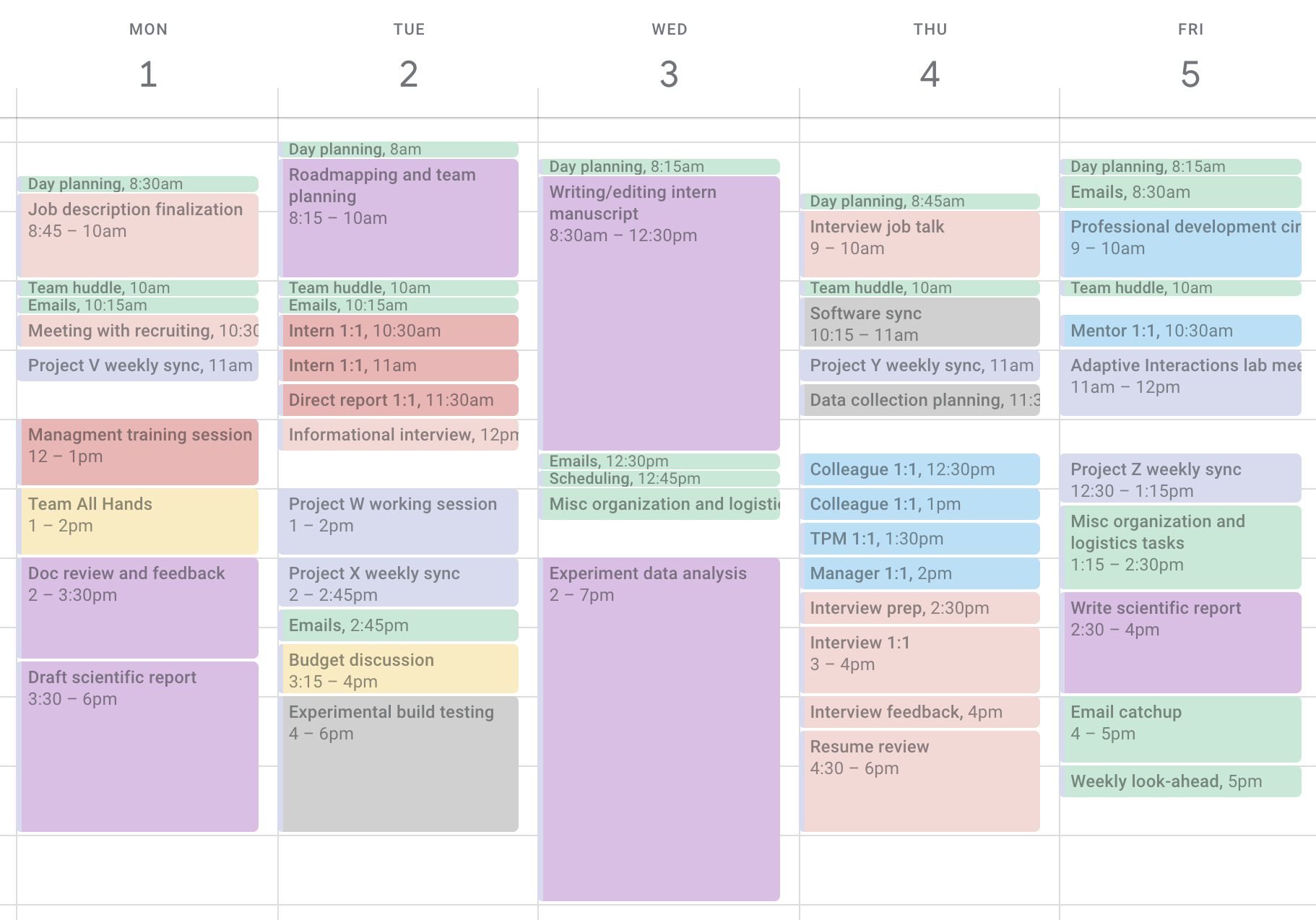Train your Mind to Interrupt Cycles of Unproductivity
At the end of every week, my calendar looks something like this:

Don’t be alarmed – they aren’t all meetings! Some of them are but the rest of these events are the result of my time-tracking practice.
I’ve been tracking my time for 3 years now. Each time I change tasks during my workday, I record the most recent activity in 15-minute increments and categorize it. This practice might seem unnecessarily tedious, but for me and my work style, it has been a game changer. So why do I do it?
Why I Track my Time
Time is a limited resource. You could have all the money in the world, but you can’t buy more minutes in a day. The best you can do is ensure that those minutes are spent on your most meaningful activities.
Perhaps you’ve had the experience of suddenly realizing that you’ve spent a few hours spinning your wheels without making any real progress. Of course, some problems require churn before they are solved because they are very difficult, but it is too easy to replace focused problem-solving with avoidant or aimless task-switching, and I wanted to decrease the amount of time I was spending on low priority activities in my workday. Time-tracking has allowed me to hold myself accountable for how I am using my time by increasing awareness of what I’m working on and whether it is the most important thing I could be doing.
When it comes to spending your time, I’m a firm believer that the best outcome you could get from a time-management practice is a mind that has been trained to recognize unproductivity and redirect time to top priorities.
The key goal here is not a macro view of my time once a week/month/quarter (although this practice can be used to achieve this as well). Instead, this practice nudges me to ask myself at each critical task-switching moment: “Were those past n minutes/hours well spent?” and “What is the most important thing I could do with the next n minutes/hours?”
Sometimes I’ll find myself coming to grips with the fact that I can’t really provide a good label for how I spent the last 45 minutes. It wasn’t entirely unproductive, but I might have spent it jumping aimlessly between chat, email, spreadsheets, etc. When this happens, I ask myself, how did I get here? And how can I set up my workflow to prevent this from happening again in the future? Perhaps a notification pulled me into a messaging spiral (which I can turn off going forward), or maybe I’m not in the right headspace for work and instead need a powernap or a snack (snacking and napping ensue).
How I Track my Time
I have set up my time-tracking practice to foster intentionality and prioritization in the moment-to-moment decisions that I make throughout my day.
Every time I switch activities during my workday, I visit my calendar and record how I spent the last chunk of time. I do this in 15-minute increments, rounding off to the most significant activity done in that increment (if there was more than one). I’ll then attach a category label (my calendar tool has this feature), which I can use to reflect on where most of my time is going.
Sometimes people ask me why I don’t use a tool to automatically track my time. These tools allow people to take a macro view on how they are using their time across different apps and activities. While the high-level view can be valuable, I track my work hours myself - manually - because I want to reflect and prioritize each time I move between tasks.
I’ve chosen my categories to match the things I want to be doing to achieve my career goals (e.g., scientific discussions, building relationships across teams, people management, writing scientific papers) and those that are the “necessary evils” of the job (e.g., emails, logistics and organizational activities, reports). The aim here is to encourage myself to reflect on whether I’m doing the big science-y/career-building things or the less important logistical things, and to ensure that the ratio of those two is kept in check.
In fact, to support focus on the most important activities, I also block large chunks of time in my calendar (shown in purple in the calendar example). During these chunks, I turn off distractions and set aside my awareness of the clock so that I can focus on an activity that benefits from unconstrained deep thought (e.g., writing, data analysis, brainstorming). In most research jobs, these large undisrupted blocks are probably when you do your most important and impactful work. Don’t forget to prioritize these!
Assess and Reassess the Value of your Practices
When I started time-tracking, I thought it would provide “training wheels” and that at some point I’d stop needing it. But as I’ve progressed in my career, I’ve instead found that prioritization has become increasingly important. My mental muscle has grown at the same rate as my career prioritization demands, which means that I’m still benefiting from the technique. And so, I keep on tracking for now.
That said, don’t get too obsessive about tools. The tools are there to serve you and not vice versa. If something isn’t working or stopped working, try something new, or acknowledge that perhaps you’ve already arrived at jedi-level time mastery!
(If you’d like to receive an email notification when I publish new essays, you’re welcome to subscribe to my mailing list. Needless to say, it won’t be used for spam or other nonsense.)